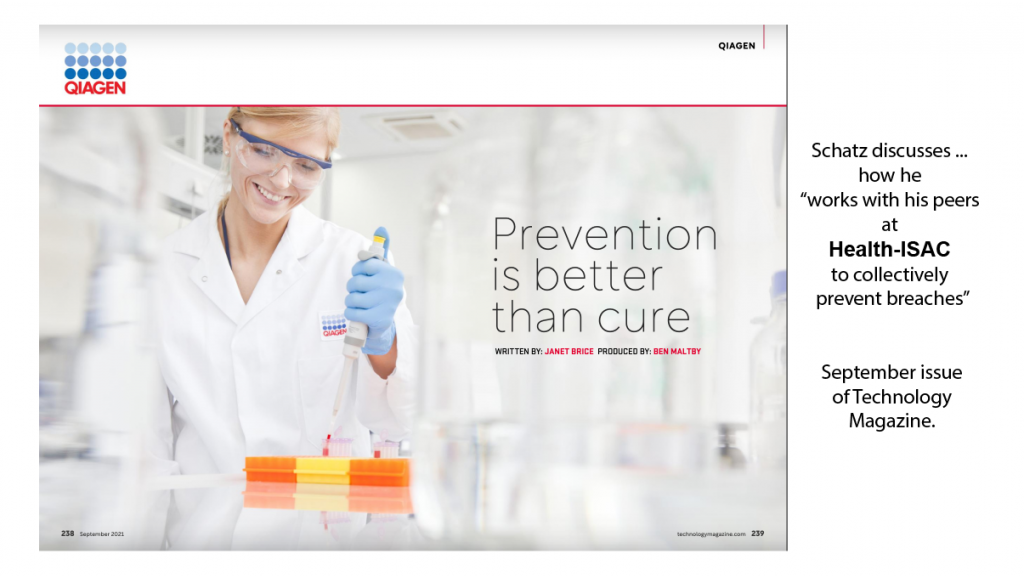Prevention is Better Than Cure
A Health-ISAC member shares how participating in Health-ISAC threat intelligence information sharing
with industry peers adds to their organization’s resilience.

Prevention is Better Than Cure
Technology Magazine September 2021 – page 239
Written by: Janet Brice — Produced by: Ben Maltby
Link to article on page 239: https://issuu.com/gigabitmagazine/docs/technology-magazine-september-2021/250
Prevention is better than cure. Today, this old adage not only applies to health but also to the welfare of successful organizations like biotech pioneer QIAGEN which is placing cybersecurity under the microscope and top of its agenda.
This invisible threat landscape, which is growing exponentially, means the role of Dr. Daniel Schatz, Chief Information Security Officer of QIAGEN, is more important than ever as he works to protect the assets of the global provider.
… Schatz discusses how he works to protect QIAGEN from “opportunist” attacks, the impact of the COVID-19 pandemic on cybersecurity, how he works with his peers at Health-ISAC to collectively prevent breaches, and the importance of their ecosystem of key partners which include Tata Consultancy Services (TCS).
“I’m responsible for the information security risk management programme at QIAGEN. My role is to protect the organization from cyber attacks and ensure information and digital risks are appropriately managed across the board.
Clear and Present Danger
The clear and present danger of a cyber attack is never far from the mind of Schatz who joined QUIAGEN two years ago from a previous role at the international news agency Thomas Reuters – another organization renowned for its sensitive data. “As a CISO we tend to have a low profile but if things suddenly go wrong, we become the most crucial person in the organization.”
“Attacks are increasing, which is little surprise considering how quickly organized cyber-criminals are improving their craft. A few years ago it was all very basic. You could buy basic malware packages and later on you could rent some basic botnets. We used to say in cybersecurity – you don’t need to outrun the bear, you just need to outrun the person next to you. But today, you have to outrun several bears…”
Opportunistic Attacks
According to Schatz, [attacks] are mostly opportunistic but the cyberattackers tend to target the same industry until they are successful which is one of the reasons they have gotten together with Health-ISAC, a health information sharing and analysis centre, to work together to try and avert future attacks.
…”There are of course, threat actors who target industries and organizations for other reasons. Through our involvement with industry peer groups, government relations, and information exchanges the Health-ISAC we’re keeping a close eye on developments in this space…”
Read the full article in Technology Magazine’s September 2021 issue, beginning on page 239. Here is the link: https://issuu.com/gigabitmagazine/docs/technology-magazine-september-2021/250.
- Related Resources & News
- Potential Terror Threat Targeted at Health Sector – AHA & Health-ISAC Joint Threat Bulletin
- New Cybersecurity Policies Could Protect Patient Health Data
- CyberWire Podcast: PHP flaw sparks global attack wave
- Health-ISAC Hacking Healthcare 3-14-2025
- HSCC Aiming to Identify Healthcare Workflow Chokepoints
- New Healthcare Security Benchmark Highlights Key Investment Priorities and Risks
- Are Efforts to Help Secure Rural Hospitals Doing Any Good?
- CISA cuts $10 million annually from ISAC funding for states amid wider cyber cuts
- 2024 Health-ISAC Discussion Based Exercise Series After-Action Report
- Cobalt Strike takedown effort cuts cracked versions by 80%
